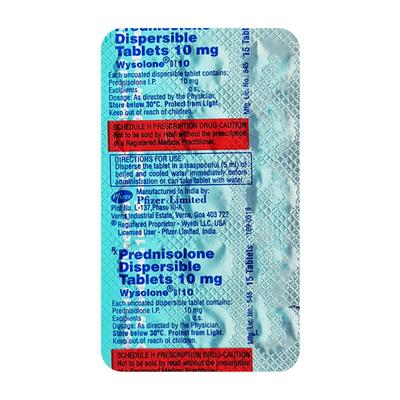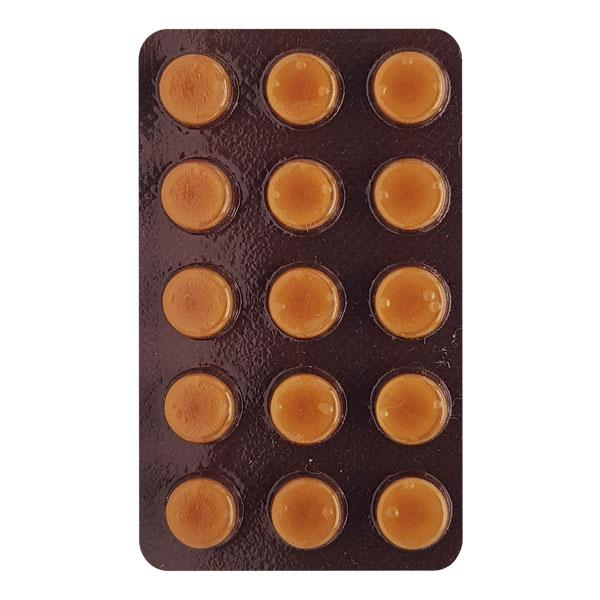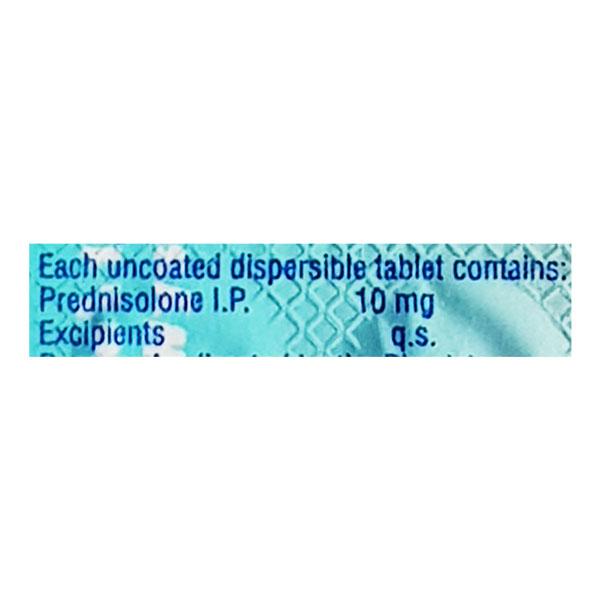

Netmeds First Membership
Quick Links
Introduction About WYSOLONE 10MG TABLET
What is WYSOLONE DT 5mg?
WYSOLONE DT 5mg contains Prednisolone, a corticosteroid that supports the management of various conditions linked to inflammation and immune response. This dispersible tablet is prescribed by healthcare providers for allergic reactions, rheumatic concerns, and certain chronic conditions where immune regulation is required.
Prednisolone in WYSOLONE DT 5mg works by decreasing substances in the body that drive inflammation and immune overactivity. This effect helps with symptoms like redness, swelling, and irritation across multiple organ systems.
Before taking WYSOLONE DT 5mg, share your all current medicines, conditions, and allergies with your doctor. Discuss if you are having diabetes, hypertension, or immune conditions. Check with a doctor if pregnant, planning, or breastfeeding women.
Monitor for side effects such as mood changes, weight gain, upset stomach, or infections; report persistent symptoms promptly.
Uses Of WYSOLONE 10MG TABLET
Health Benefits Role in Health Management
- Helps control symptoms in allergy, skin, and joint concerns
- Often chosen for auto-immune, endocrine, and some respiratory challenges
- May be included in care plans for blood disorders, gastrointestinal discomfort, and eye or nerve issues as determined by the doctor
How WYSOLONE 10MG TABLET Works
How WYSOLONE DT 5mg Supports Health
Prednisolone in WYSOLONE DT 5mg works by decreasing substances in the body that drive inflammation and immune overactivity. This effect helps with symptoms like redness, swelling, and irritation across multiple organ systems.
Prednisolone Mechanism Explained
- Prednisolone is a synthetic corticosteroid that binds to glucocorticoid receptors within cells
- This binding triggers changes in gene expression, which suppresses pro-inflammatory signals and promotes anti-inflammatory processes
- It inhibits phospholipase A2, managing the formation of inflammatory mediators such as prostaglandins and leukotrienes
- Prednisolone reduces the migration of immune cells (leukocytes) to sites of inflammation and decreases capillary permeability, helping manage swelling and redness
- It blocks inflammatory transcription factors (like NF-Kappa B) and enhances the production of anti-inflammatory proteins such as interleukin-10
- At low doses, it mainly acts as an anti-inflammatory agent; at higher doses, it can suppress immunity more broadly
- Long-term or high-dose use may affect water, electrolyte balance, and metabolic processes, emphasizing the need for medical monitoring
How to use WYSOLONE 10MG TABLET
- Follow the doctor’s guidance for dosing type and schedule
- Tablet is dispersible: Can be dissolved in water for ease of intake
- Best taken with food or as advised to reduce stomach discomfort
- Adherence to timing boosts effectiveness
1. Dosage Instructions and Timing
- The initial dosage of WYSOLONE DT 5mg Tablet varies from 5 mg to 60 mg per day, dependent on the specific condition and disease severity.
- Always take the tablet strictly as prescribed by your doctor, at the same time(s) each day for optimal effect.
- The dispersible tablet should be dissolved in water before intake, or swallowed whole with water if preferred.
- Your doctor will determine the right dose and may adjust or taper it gradually-never change dosing on your own.
2. Safe Administration Guidelines
- Swallow the tablet whole; do not crush, chew, or cut it unless directed for dispersible use.
- Take with or after food to reduce stomach discomfort, unless told otherwise.
- Inform your doctor about all other medicines, supplements, and your full medical history before starting, especially regarding infections, liver, or kidney issues.
- Avoid abrupt discontinuation; dose reduction should be done gradually as per medical advice.
What if I forgot to take WYSOLONE 10MG TABLET
If you miss a dose, take it as soon as you remember. If it is close to your next scheduled dose, skip the missed dose, do not double the dose.
Overdose
- Overdose can cause serious side effects; seek immediate medical attention if an excess amount is taken.
- Keep track of your doses and maintain a consistent medication routine to prevent missed or extra doses.
Side Effects Of WYSOLONE 10MG TABLET
- mood changes
- weight gain
- upset stomach
- infection
When to Seek Medical Advice?
- Contact your doctor immediately if you experience severe mood changes, confusion, fits, suicidal thoughts, or mental health disturbances while taking WYSOLONE DT 5mg Tablet.
- Seek prompt medical attention for allergic reactions such as swelling of the face or throat, difficulty breathing, or severe rash.
- Inform your healthcare provider about any visual disturbances, persistent infections, unexplained fever, blood in stool, or muscle weakness.
Managing and Reporting side Effects
- Monitor for common side effects such as increased appetite, weight gain, insomnia, mood changes, stomach discomfort, and report any persistent or bothersome effects to your healthcare provider.
- Most minor side effects fade as your body adjusts; contact a doctor if side effects are severe, prolonged, or impact daily activities.
- Notify your provider of any signs of infection (fever, chills, coughing), skin allergies, high blood sugar, or high blood pressure.
- In case of suspected overdose (taking more tablets than prescribed), seek immediate medical help at the nearest hospital.
- Maintain a record of any unusual reactions or behaviors and provide this info during follow-ups for effective care and medication review.
Warning & Precautions
Pregnancy
Consult your doctorConsult with a doctor if you are pregnant or planning to get pregnant before taking WYSOLONE DT 5mg Tablet.
Breastfeeding
Consult your doctorConsult with a doctor if you are a breastfeeding women before taking WYSOLONE DT 5mg Tablet.
Driving and Using Machines
Use with CautionDo not drive or operate any machines if you feel dizzy or sleepy after taking WYSOLONE DT 5mg Tablet.
Kidney
Use with CautionWYSOLONE DT 5mg Tablet should be used with caution in patients with renal insufficiency.
Allergy
ContraindicatedDo not take WYSOLONE DT 5mg Tablet if you are allergic to Prednisolone or any other ingredients of this medicine.
Heart Disease
Use with CautionWYSOLONE DT 5mg Tablet should be used with caution, and only if strictly necessary, in cases of congestive heart failure.
Use In Pediatrics
Consult your doctorWYSOLONE DT 5mg Tablet may cause growth retardation in infancy, childhood and adolescence and therefore, long-term administration of pharmacological doses should be avoided. If prolonged therapy is necessary, the growth and development of infants and children should be closely monitored.
Other Warnings for WYSOLONE 10MG TABLET
Before taking WYSOLONE DT 5mg Tablet, inform your doctor if you:
- Diabetes
- Hypertension
- immune conditions
Safety Advice
- Share details of all current medicines, conditions, and allergies with your provider before starting the medicine
- Discuss if living with diabetes, hypertension, or immune conditions
- Check with a doctor if pregnant, planning, or breastfeeding
- Monitor for side effects such as mood changes, weight gain, upset stomach, or infections; report persistent symptoms promptly
Drug - Drug interaction
|
Drug/Class |
Type/Effect |
Clinical Note |
|
CYP3A4 inhibitors (e.g. ketoconazole, troleandomycin) |
Increased prednisolone levels |
Risk of adverse effects; dose adjustment may be needed |
|
CYP3A4 substrates |
Altered drug clearance |
Clearance of both drugs affected; monitor for increased adverse events |
|
Oral contraceptives (estrogen) |
Increased prednisolone effect |
Monitor for hormone-related side effects |
|
Azole antifungals (ketoconazole, itraconazole) |
Increased steroid level |
Risk of swelling, high blood glucose, dose adjustment needed |
|
Antihypertensives |
Reduced effectiveness |
Monitor blood pressure, may need dose adjustment |
|
NSAIDs (ibuprofen, aspirin) |
Increased risk of GI bleeding |
Use with caution; monitor for stomach discomfort |
|
Fluoroquinolone antibiotics |
Tendon risk, especially in elderly |
Monitor for pain/swelling in joints |
|
Antacids, some antibiotics (rifampin, erythromycin) |
Reduced steroid effectiveness |
Administer with gap if possible; monitor symptoms |
|
Antidiabetic agents (insulin, gliclazide, glibenclamide) |
Increased blood sugar |
Monitor glucose regularly, may need dose change |
|
Immunosuppressants (cyclosporine, methotrexate) |
Stronger immune suppression |
Risk of infections; consult physician for dose adjustment |
|
Anticonvulsants (phenytoin, phenobarbital, carbamazepine) |
Reduced steroid effect |
Dose adjustment may be necessary |
|
Diuretics (water pills) |
Electrolyte imbalance |
Monitor for potassium changes, heart rhythm |
|
Vaccines (live) |
Reduced efficacy |
Avoid live vaccines during therapy |
Drug - Food interaction
- Gastric irritation may be reduced if WYSOLONE DT are taken with meals or with food or milk
- Salt Intake: It is advisable to limit sodium-rich (salty) foods and processed snacks, as corticosteroids may increase the risk of fluid retention and high blood pressure
- Sugar & Carbohydrate Caution: Diabetic or prediabetic patients should monitor intake of sugars and refined carbs, since prednisolone can raise blood sugar levels
Synopsis
| Drug | : | Prednisolone |
| Pharmacological Category | : | Glucocorticoid |
| Therapeutic Indication | : | Management of various conditions linked to inflammation and immune response |
| Dosage Forms | : | Tablet |
More Information
Recent studies highlight the importance of regular monitoring, dietary modifications, and gradual dose adjustments for ongoing corticosteroid use
- Regular Monitoring: Patients should undergo baseline and periodic checks of blood pressure, blood glucose, and lipid profile due to increased risk of hypertension, diabetes, and dyslipidemia with long-term steroid use. Bone mineral density (BMD) should be assessed at baseline, at 1 year, and then every 1–3 years as indicated; regular monitoring for vision changes and signs of infection is also recommended.
- Dietary Modifications: Patients are encouraged to limit salt and processed foods (for blood pressure control), limit simple sugars (to reduce risk of insulin resistance), and ensure sufficient intake of calcium and vitamin D-rich foods to preserve bone health. Weight-bearing exercise and healthy nutrition further help mitigate osteoporosis and metabolic risks.
- Gradual Dose Adjustments: When corticosteroid therapy needs to be tapered or discontinued, guidelines emphasize slow, individualized dose reduction to manage adrenal suppression and withdrawal symptoms. Ongoing symptom assessment and periodic cortisol testing (as advised by specialists) help determine the pace of dose reduction.
- Special Monitoring for Children: Height and growth parameters in children and adolescents should be monitored every 6 months to detect growth suppression early
Use evidence-based facts - such as common side effects statistics or insights from published product monographs - to help customers feel confident in decision making
Common Side Effects: Statistics & Insights
- Bone density reduction: Occurs in up to 30% of patients with long-term use, especially in women post-menopause.
- Weight gain and increased appetite: Reported by over 20% of users during ongoing corticosteroid therapy.
- Mood and behavioral changes (irritability, anxiety, and sleep disturbances): Affect around 10-15% of patients according to published clinical reviews.
- Upset stomach and indigestion: Seen in more than 10% of patients, especially if taken without food.
- Fluid retention and rise in blood pressure: Can be found in up to 15% of chronic users, making regular monitoring important.
Additional Safety Insights
- Vision disturbances, cataracts, and growth suppression in children are less common but clinically significant with long-term therapy, routine monitoring is advised.
- Altered blood glucose and increased risk of diabetes: Noted in up to 10% of those with prolonged or high-dose use, according to product monographs and medical studies.
- Most side effects improve as your body adjusts to the medicine, but persistent or severe symptoms must be discussed with your doctor for safe management.
FAQs About WYSOLONE 10MG TABLET
Q: What conditions can WYSOLONE DT 5mg Tablet be used for?
A: It is used for managing allergies, autoimmune disorders, inflammatory conditions and manage organ rejection after transplantation. It helps reduce inflammation and modulate immune response.
Q: What side effects might I experience?
A: Common side effects include increased appetite, weight gain, mood changes, trouble sleeping, and stomach discomfort. Long-term use can affect bone health, blood sugar, and increase infection risk, so monitoring is necessary.
Q: Can I stop prednisolone suddenly?
A: No, sudden stopping can cause serious withdrawal symptoms because your body needs time to resume natural steroid production. Dose reduction must be gradual and medically supervised.
Q: Is it suitable for older adults?
A: Prednisolone is generally suitable for older adults but requires special caution and monitoring to balance benefits with risks.
Q: What foods or medicines should be avoided?
A: Foods to Avoid like High-sodium and processed foods, Sugary and simple carbohydrates, Foods high in saturated fats and cholesterol. Medicines to Avoid or Use with Caution such as NSAIDs (ibuprofen, aspirin), Diuretics, Blood thinners (warfarin), Certain antibiotics and antifungals, Live vaccines and Diabetes medications,
Q: What to do if a dose is missed?
A: Take it as soon as you remember on the same day, preferably with food to reduce stomach upset. Try to take it earlier in the day if possible to avoid sleep disruption. Skip the missed dose. Do not take a double dose to make up for the missed one as this can increase side effects risk.
Q: How to store WYSOLONE DT 5mg Tablet safely?
A: Store the tablet at room temperature, ideally between 20°C to 25°C (68°F to 77°F), avoiding exposure to excessive heat or cold. Store the medication in a dry place, away from bathrooms or damp environments that can cause tablet deterioration.
Q: What monitoring is needed during therapy?
A: Doctors may monitor blood pressure, blood sugar, bone density, eye health, and signs of infection regularly during prolonged use.
Q: How should I take WYSOLONE DT 5mg Tablet?
A: Take it orally exactly as prescribed by your doctor. The tablet can be dissolved in water if indicated, or swallowed whole. Follow the prescribed dose, usually once daily, and do not stop abruptly without medical advice
References
1. KD. Tripathi. RESPIRATORY SYSTEM DRUGS. Essentials of medical pharmacology. Eighth edition. 2019. Page – 242.
2. Yana Puckett, Preeti Patel, Abdullah A. Bokhari. Prednisone. National Library of Medicine. [Revised on April 26, 2025] [Accessed on 30th October 2025] ![]()
3. Pfizer Limited. [Revised on May 2025] [Accessed on 30th October 2025] 










